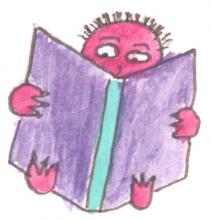What is "Guess and Go" Spelling?
"Mi sistr iz prte." ("My sister is pretty.") This is an example of a sentence that a student using 'Guess and Go' spelling might write. Using this technique is an important part of writing development.

Most children begin their writing journey by story-telling through pictures. If you look back through the work of your own child as a beginning writer, you'll likely notice that more details begin to emerge as your child grew older. This is their way of telling the story with more specifics. In class, I encourage students to add more details to their pictures by asking them questions such as, "Who else was there with you?" or "Where were you?" Or I may comment: "I notice the sun is in the sky, so it must have been day time when this happened." Pictures, followed by more detailed pictures is the first step in the developmental writing continuum.
Next, children may begin to add shapes that look to you or I like scribbles, but they actually resemble words. Your child will likely place these lines under their pictures, the same way the story books you read to him or her do. This is something to celebrate, your child has been noticing that those little black letters below the pictures mean something! Now, your child has a meaningful story to tell as well! Ask your child to 'read' his or her story to you and notice all that they can tell you about this! You can also encourage reading from left to right and top to bottom.
Next, your child will begin to form actual letters and those letters will begin to represent the sounds that you and I know. This is when 'guess and go' spelling is encouraged. Children often hear the first sound in a word when they are first learning to write. So the sentence "My sister is pretty." may actually look like this: "MS is P". This shows that the child is hearing the first letter of each word, and that she either knows the sight word 'is' or uses a sight word chart for assistance (using tools such as that is a great strategy!).
The next step is likely that your child will hear the last sound in a word, and after practice with breaking words into syllables and sound chunks, he will begin to hear the middle sound as well. This results in something such as the sentence we have been looking at: "Mi sitr iz prte."
This stage is where children tend to hang out for quite awhile. Many stay here for a few years. The reason this stage of writing is so important, is that it helps children gain confidence in themselves as writers. If a child has to ask how to spell each word she writes, she begins to rely on the person she is asking so much that she may become unable to write without that person around. However, when given the freedom to 'write what she hears' she has the tools to begin to write independently. I have seen this happen. Recently, one student had a lovely story written in pictures. I asked the child if they could read me their story. Once the student read their story to me, I picked out the main word in the story, in this case it was 'love'. Next, I said the word to the child, "Love, can you hear the first sound in the word love?" The child wrote 'L'. I responded, "Love, what else can you hear?" The child wrote 'V'. Next (and here's where it gets really good, the child looked up at me with a smile and said, "Love! I wrote love!" I went off to help other students and when I came back around to this child, there was another word on the paper. "FRD" I asked the child to read it to me. "Friend", the child read to me. "I love my friend because every time we play together we laugh. Here we are at the park yesterday. We went down the slide." This child is learning independence, as well as telling a detailed story that was important to them.
Please continue to help your child gain writing fluency by encouraging 'guess and go' spelling. We will spend time when we edit making sure that 'all of the words can be read by everyone.' You can also work with your child on phonics and spelling patterns, but try doing this as a separate lesson/message than during writing time.
The next stage of writing is when students begin to combine the proper spellings into their fluent writing. Now they have the tools to write independently, so it's just a matter of time until "My sister is pretty." is the sentence that lands on the paper!





